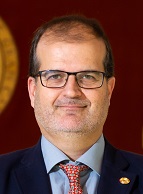- Presentation
- Members
- Research Lines
- Projects
Presentation
The Mathematics, Graphics, and Computing (MAGiC) division promotes activities of scientific and technical research and innovation that revolve around the application of Mathematics, Geometry, Engineering, and Computer Science.
It was founded in 2012 and stems from the merger of the former research group on Meshes and Computational Geometry (MGC, 1999), part of the SICAD division of IUMA, and other lines of work from the School of Industrial and Civil Engineering of the University of Las Palmas de Gran Canaria.
Some notable projects include:
- Mesh methods for representing the visual impact of energy installations in virtual and augmented reality environments.
- Development of an augmented reality engine based on geolocation for mobile devices. Incorporation of GIS capabilities in virtual globes.
- Triangular partitions and refinement algorithms.
The teaching and research staff of the division consists of 6 people, accumulating a total of 10 six-year research periods, over 90 impactful publications, and 30 research projects.
Director:
Mathematics, Graphics, and Computing (MAGiC)
Responsible: Dr. José Pablo Suárez Rivero
UNESCO Codes: 3307, 3304, 1206
SL3.1: Mesh Generation and Refinement Algorithms
T1: Development and application of mesh refinement and derefinement algorithms
Mesh generation and refinement algorithms are techniques for discretizing geometric domains in any dimension. Research activities in this line focus on the design, implementation, and validation of new refinement and derefinement algorithms. We also address, through mathematical methods, the characterization and properties of these algorithms, such as convergence, quality, finiteness, etc.
SL3.2: Computational Geometry and Geometric Design
T1: Computational Geometry and Geometric Design
Computational Geometry and Geometric Design are interdisciplinary research areas that involve mathematics, computer science, and engineering. This line integrates three more specific sub-areas: Meshes, Surfaces, Subdivision, and Multiresolution. We focus on algorithms, data structures, and geometric properties of meshes and surfaces with an interest in engineering.
SL3.3: Generalized Fibonacci Sequences
T1: Certain types of generalized Fibonacci sequences
Numerical and geometric properties of integer sequences are studied. Among them, the k-Fibonacci sequences have been defined, which are a generalization of the classical Fibonacci sequence. These sequences appear in various fields of science, such as physics, architecture, and even biology. They are also related to Pascal's triangle and its generalizations, triangulations, polynomials, generalized hyperbolic functions, and complex variable theory.
SL3.4: Graphics Engineering, Modeling, and CAD
T1: Graphics Engineering, Modeling, and CAD
It focuses on techniques and tools for geometric representation and modeling. There is specialized 2D and 3D software, including CAD tools. This line aims at their efficient use for producing high-quality graphic information in engineering, such as the development of plans and 3D models and advanced visualization.
SL3.5: Geodetic Engineering and Geospatial Applications
T1: Geodetic Engineering and Geospatial Applications
Analysis of GNSS (Global Navigation Satellite System) data using application software. For example, an automatic and visual application for the selection of GNSS stations is developed. Development of geo-referenced virtual balloons for personal computers and mobile devices. Some achieved results in which we have participated include Capaware and Glob3 mobile. Capaware and Glob3 mobile.
Mesh methods for representing the visual impact of energy installations in virtual and augmented reality environments.
Principal Investigator: Dr. Miguel Ángel Padrón Medina
Code: CABILDO2018-01 (SI-1546)
Funded by: Cabildo de Gran Canaria
Start Date: 2019 ― End Date: 2019
